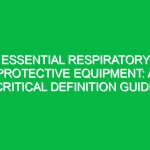Introduction
In today’s fast-paced world, the concept of reduced risk has become paramount in the Health, Safety, and Environment (HSE) domain. Reduced risk refers to the systematic approach to minimizing potential Hazards and their consequences, ensuring the well-being of individuals, communities, and ecosystems. The relevance of reduced risk in HSE cannot be overstated; it serves as a foundation for developing policies, procedures, and practices that prioritize Safety and Sustainability.
Imagine a construction site bustling with activity. Heavy machinery operates alongside workers who are diligently following Safety protocols. However, beneath the surface, various risks lurk, ranging from equipment malfunctions to environmental Hazards. This scenario emphasizes the need for comprehensive strategies that not only address immediate dangers but also promote a culture of safety and environmental stewardship.
This article delves into essential strategies for reduced risk within the HSE context, exploring key concepts, regulations, and Best Practices that organizations can adopt to foster a safer and more sustainable environment.
Understanding Reduced Risk in HSE
Reduced risk encompasses a range of practices aimed at identifying, assessing, and mitigating hazards across various sectors. Understanding the underlying principles is crucial for effective implementation. Here are some key components:
1. Risk Assessment
Risk assessment is the cornerstone of any effective HSE strategy. It involves systematically identifying potential hazards, evaluating the likelihood and severity of their impact, and determining appropriate Control Measures. Organizations often utilize methods such as:
- Qualitative Assessment: This approach evaluates risks based on descriptive analysis and expert judgment.
- Quantitative Assessment: This method employs statistical data to calculate probabilities and potential impacts.
For instance, a manufacturing plant may conduct a quantitative risk assessment to analyze machinery failures, leading to the implementation of preventative Maintenance schedules.
2. Safety Management Systems (SMS)
A Safety Management System provides a structured framework for managing safety risks. An effective SMS involves:
- Establishing safety policies and objectives
- Conducting regular Training and drills
- Monitoring compliance with safety Regulations
Real-life example: A chemical processing facility adopted an SMS that significantly reduced workplace accidents by promoting a proactive safety culture. The facility engaged employees in safety meetings and encouraged them to report hazards, leading to a notable decrease in incidents.
3. Incident Reporting and Investigation
Encouraging a culture of transparency around incident reporting is critical for reducing risk. Organizations should establish clear Procedures for reporting accidents, near-misses, and unsafe conditions. Furthermore, thorough investigations should follow to identify root causes and implement corrective actions.
Consider the case of a logistics company that experienced a series of near-miss incidents involving forklifts. By implementing a robust incident reporting system, the company identified a common factor: inadequate training. Subsequently, they enhanced their training programs, resulting in improved safety outcomes.
4. Employee Involvement and Training
Engaging employees in safety practices is vital for reducing risk. Regular training sessions empower workers with knowledge about hazards and Safe Practices. Additionally, involving employees in safety committees fosters a sense of ownership and responsibility.
A construction firm that implemented a peer-led safety training program witnessed a dramatic reduction in accidents. Workers felt more accountable for their safety and that of their colleagues, creating a culture of vigilance and support.
Hazards and Risks in HSE
Understanding the types of hazards is essential for effective risk reduction. Hazards can be categorized into several types:
- Physical Hazards: These include slips, trips, falls, and exposure to machinery.
- Chemical Hazards: Exposure to harmful substances, such as toxic chemicals and fumes.
- Biological Hazards: Risks from exposure to bacteria, viruses, and other pathogens.
- Ergonomic Hazards: Issues arising from poor workstation design or repetitive motions.
Each category presents unique challenges that require tailored strategies for reduced risk. For example, a hospital might implement strict protocols for handling biological materials to mitigate exposure risks for healthcare workers.
Best Practices for Reducing Risk
To effectively reduce risk in the HSE domain, organizations should adopt several Best Practices:
1. Regular Audits and Inspections
Conducting regular audits and inspections helps organizations identify potential hazards before they lead to incidents. These assessments should cover:
- Workplace conditions
- Equipment functionality
- Compliance with safety Standards
For instance, a food processing plant discovered safety gaps during a scheduled audit, leading to immediate corrective actions and improved compliance with health regulations.
2. Emergency Preparedness and Response Plans
Every organization should have comprehensive emergency preparedness and response plans. These plans should outline procedures for various scenarios, such as natural disasters, chemical spills, or workplace violence. Regular drills ensure that employees are familiar with procedures, enhancing readiness.
A real-life example includes a university that faced a severe weather event. Their well-rehearsed emergency response plan enabled a swift evacuation, minimizing injuries and ensuring the safety of students and staff.
3. Continuous Improvement and Feedback Loops
Establishing mechanisms for continuous improvement is vital. Organizations should regularly review their safety policies, gather employee feedback, and adapt strategies based on lessons learned from incidents.
An oil and gas company, for example, implemented a feedback loop that allowed workers to suggest improvements to safety protocols. This initiative not only enhanced Safety Measures but also fostered a culture of collaboration and trust.
4. Technology Integration
Leveraging technology can significantly enhance risk reduction efforts. Tools such as safety management software, incident reporting apps, and wearable technology can streamline processes and improve data collection.
For instance, a construction company utilized wearable sensors to monitor worker fatigue and environmental conditions, reducing the likelihood of accidents and ensuring a safer work environment.
Regulations and Standards Impacting Reduced Risk
Compliance with regulations and standards is a crucial aspect of reducing risk in the HSE context. Various regulatory bodies establish guidelines that organizations must adhere to, including:
- Occupational Safety and Health Administration (OSHA): In the United States, osha sets and enforces Workplace Safety regulations.
- Environmental Protection Agency (EPA): The EPA regulates environmental practices to protect human health and the environment.
- International Organization for Standardization (ISO): ISO standards, such as ISO 45001 for Occupational Health and safety, provide frameworks for effective risk management.
Organizations that prioritize compliance not only mitigate legal risks but also enhance their reputation and stakeholder trust. A manufacturing firm that adopted ISO 45001 standards reported fewer workplace incidents and an improvement in overall employee morale.
Conclusion
In conclusion, reducing risk in the Health, Safety, and Environment domain is essential for safeguarding individuals, communities, and the planet. By implementing comprehensive strategies such as risk assessments, safety management systems, and employee training, organizations can foster a culture of safety and sustainability.
Moreover, adherence to regulations and standards reinforces the importance of reduced risk, ensuring that safety practices are not merely optional but integral to organizational operations. As we navigate an increasingly complex world, prioritizing reduced risk will not only protect workers but also contribute to a more sustainable future.
Organizations must continue to reflect on their practices, engage employees, and embrace technology in their quest for reduced risk. By doing so, they will not only protect their workforce but also create a legacy of safety and environmental responsibility that resonates far beyond their immediate surroundings.


